Phytoplankton Monitoring Project
On Friday, March 29, 13 citizen scientists, traveled to Sapelo Island for Phytoplankton Monitoring training. Phytoplankton, commonly called Algae, are the base of the estuarine food chain and are an essential part of the estuarine ecology. However, there is good algae and toxic algae and when toxic algae reproduce in large numbers it is called a “Harmful Algae Bloom (HAB).” The goal for the newly trained scientists is to identify the toxic algae types and monitor their growth. Sounds easy, right!
First part of the morning was spent in the classroom, identifying the equipment and the techniques for collecting the algae. Then it was on to the dock where volunteers took turns collecting water and recording the salinity of the water. The afternoon was dedicated to learning how to identify the different types of algae under the microscope.
As you can see from the expressions on the faces of the group, as they peered into their microscopes, finding and identifying the different organisms was somewhat overwhelming.
The good news, on this day, the water in Post Office creek was not showing any sign of a HAB. The volunteers will return to Sapelo twice a month for the next year, to collect and record their findings in the national Phytoplankton Monitoring Network database.
If you are interested in coming in joining the ranks of Citizen Scientists, watch this site for future opportunities or contact Dr. Rachel Guy, SINERR Research Coordinator, at rachel.guy@dnr.ga.org

































